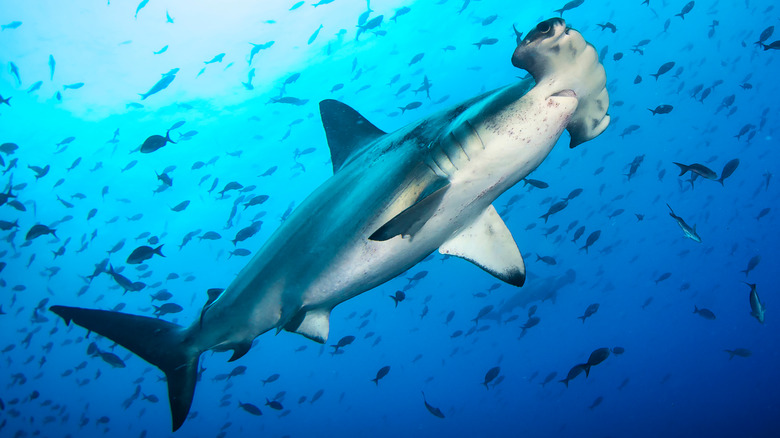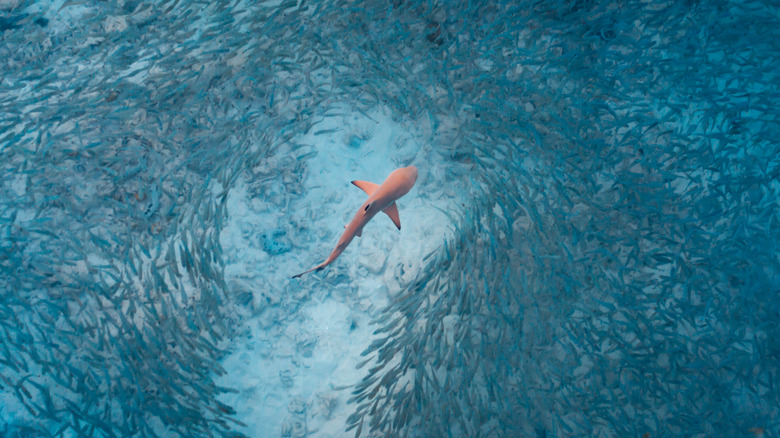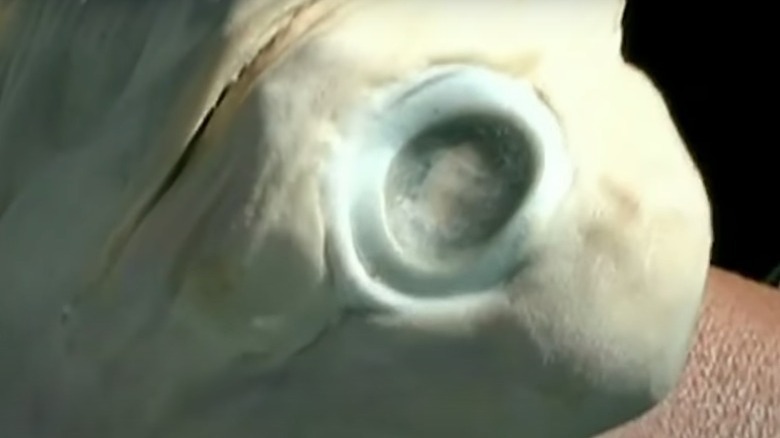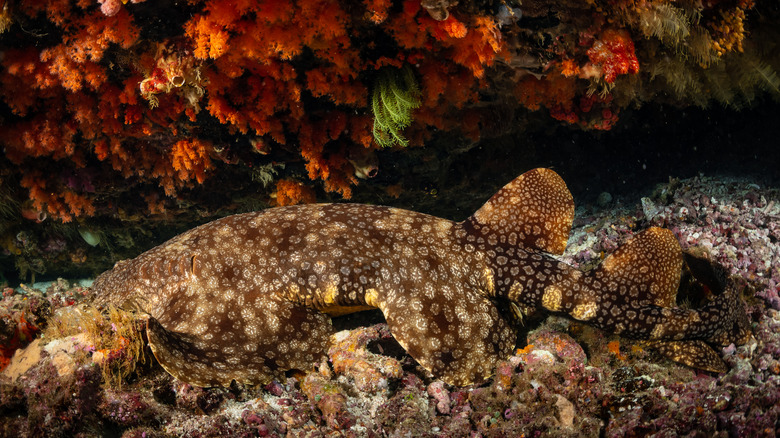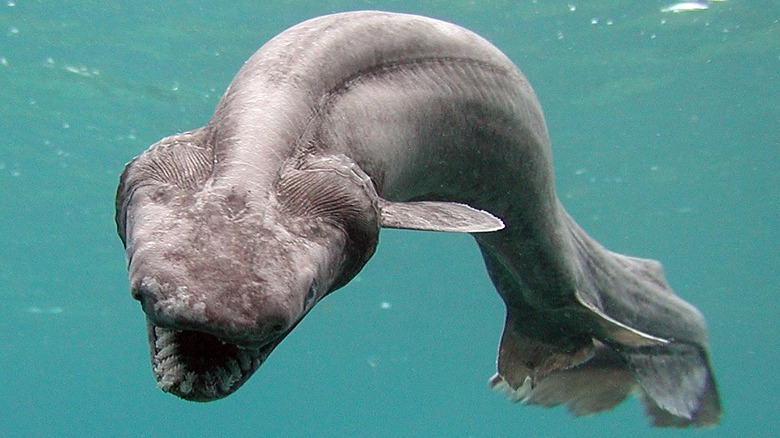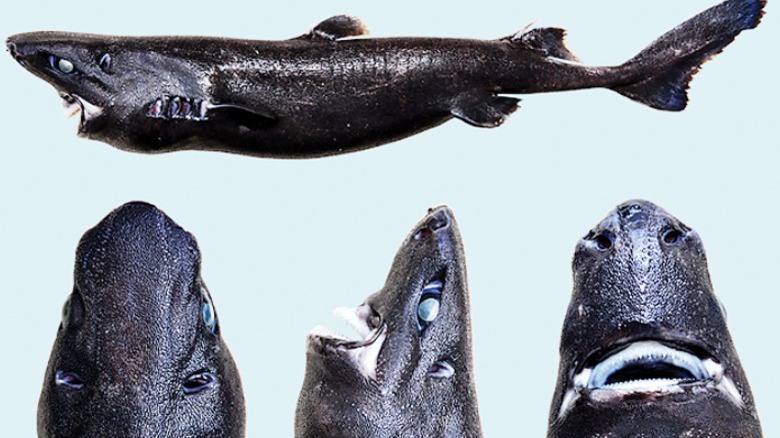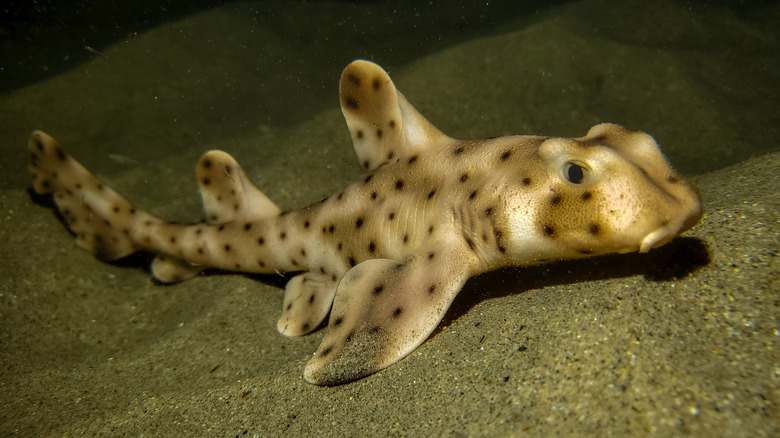The Six Strangest Sharks You've Probably Never Heard Of
Over 80% of our oceans remain unexplored by humans. There are more detailed maps of the Moon and Mars than our own oceans on Earth (via National Geographic). Because of this, new species of sea life are being discovered every day. When it comes to sharks, most people imagine the Great White or Tiger shark, but many more exist. With over 500 species of shark that have been discovered so far, there are bound to be some strange ones that most of us have never heard of (via Smithsonian).
When you think of unique sharks, you might think of the strangely shaped head of the hammerhead shark, the enormous size and spotted markings on the whale shark, or perhaps the teensy-tiny dwarf lantern shark — about as big as a human hand. The fact is that species even more odd in appearance are hiding in the depths of the ocean.
1. The 'pig faced' shark
Referred to as the pig fish or pig faced shark, the angular roughshark is a unique looking species of shark. The pig faced shark gets its name from a grunting noise it makes when it exits the water. In addition to its pig-like grunt, the pig faced shark has a pair of wide-set eyes, a flat head, and a pinkish, blunt snout that all contribute to its pig-inspired name (via Live Science).
The angular roughshark lives mostly in the Mediterranean, but has also been spotted throughout the East Atlantic Ocean. It typically lives between 200-2,200 feet below the surface and usually grows to around three feet in length. The pig faced shark is considered a vulnerable species — one step up from endangered — according to the International Union for Conservation of Nature because it is often accidentally caught up in fishing nets due to its large body and spinal dorsal fins (via IUCN Red List).
2. Albino cyclops dusky shark
Found in the belly of a dead pregnant dusky shark caught by fishermen, the albino cyclops dusky shark was a malformed fetal shark that took the internet by storm. Immediately, many wondered if the shark was a photoshop hoax. Scientist were able to obtain the shark and confirm that it was, in fact, real. They also determined that, had the pregnant shark lived, the albino cyclops fetus most likely would not have survived long outside the womb (via Live Science).
Dusky sharks currently face survival issues due to a number of reasons. They have slow growth rates, a late age of maturation, and small litter sizes, all of which have contributed to the decline of the species (via the Florida Museum). Dusky sharks are also vulnerable to being caught in fishing nets, further contributing to their precarious existence. These sharks are labeled as endangered, according to the IUCN.
3. Ornate wobbegong
The ornate wobbegong is a strange-looking common carpet shark that lives in algal-covered rocky areas and coral reefs in tropical waters. They are small, elongated creatures with splotchy brown patterns covering their bodies. These splotchy patterns help the ornate wobbegong to blend in with its surroundings, hiding from predators and lying in wait for unsuspecting prey. This shark, which grows to about four feet in length, also has antenna-like appendages around its mouth that further assist it in blending in (via Shark Water).
The ornate wobbegong is currently not at risk for becoming extinct and has been given a rating of "least concern" by the International Union for Conservation of Nature. This species is not typically at risk of being caught in fishing nets and does not have any common issues that could contribute to its decline at this time. As long as its habitat is kept stable, the ornate wobbegong could continue to thrive as a species without the risk of becoming endangered.
4. Frilled shark
The frilled shark is a deep-sea shark that swims in an eel-like, serpentine fashion. This eerie shark gets its name from the frilly look of its gills. The frilled shark is capable of reaching lengths of nearly seven feet. This species eats by lunging at potential prey and swallowing it whole. Frilled sharks mostly eat squid, and their several rows of jagged, spiny teeth are perfect for snagging the soft bodies of those and other creatures.
These sharks are rarely encountered in the wild, so most information known about them is based on the dissection of frilled sharks caught by deep sea net fisheries. What little other information scientists have comes from the rare live captivity and study of these creatures. The frilled shark gives birth to live pups and does not lay eggs. It does not grow placentas, however. Instead, this strange sharks embryos gain their energy from yolk sacs in the womb (via Oceana).
5. Ninja lanternshark
The ninja lanternshark is a more recently discovered species with jet black skin, large bulbous eyes, and special cells in its skin that allow it to glow in the deep parts of the ocean it inhabits. The ninja lanternshark gets its name from a conversation between the researcher that discovered it, Vicky Vasquez, and her 8-year-old cousins. The children thought the sleek black appearance and ability to camouflage itself using bioluminescence made it sound like a ninja. They originally wanted to call it the super ninja lanternshark, but Vasquez decided to remove the "super" to give the name a better chance of being accepted by the scientific community.
The scientific name of the ninja lanternshark, Etmopherus benchley, is named after the author of "Jaws," Peter Benchley. Not much is known about this species of shark yet, but the program director for Pacific Shark Research Center (PSRC), where the shark was studied, says, "About 20% of all shark species have been discovered in just the last 10 years. My whole research is looking for 'lost sharks'." More information is currently being gathered on this and other rare species of sharks (via Hakai Magazine).
6. Horn shark
Despite its nocturnal hunting patterns, the horn shark is far from the scary, intimidating predators lurking in the dark. Instead, these sharks are quiet, unassuming, and clumsy. They are such clumsy swimmers that they sometimes use their fins to crawl along the bottom of the ocean instead. This tends to work out in their favor, however, as they eat mostly mollusks and echinoderms, which rest in the sand on the ocean floor. The horn shark is able to eat these tough snacks thanks to its sharp front teeth, which allow it to grasp prey, and its flat back teeth, which allow it to smash open shellfish with ease (via Monterey Bay Aquarium).
Horn sharks are smaller in size, reaching only four feet in length on average. They protect themselves by hiding out in crevices and under rocks. The horn shark gets its name from its built-in defense mechanism: sharp spines on its two dorsal fins that protect them from attacks. There is currently not enough data to determine if these sharks are endangered, but similarly to other sharks, the horn shark is sometimes accidentally caught by fishermen (via IUCN).
